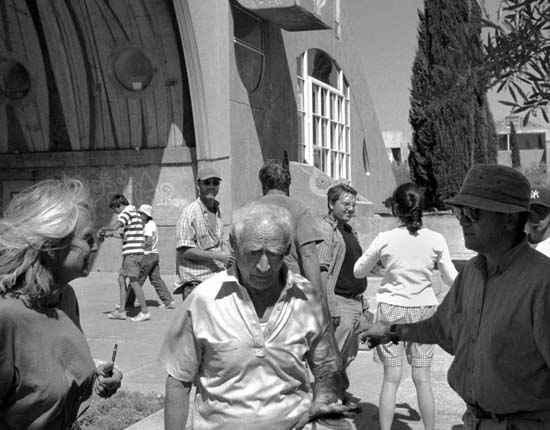Interviewsand Articles
Editor's Introduction w & c #5: Dwelling
by R. Whittaker, Aug 8, 2001

[detail] James Doolin, Twilight, 1999. oil on canvas, 82" x 72"
Issue #5 began with the thought: architecture—followed immediately by the thought, "What do I know about architecture?" On the other hand, like everyone, I’ve lived in and looked at buildings my whole life--and, come to think about it, I’ve even worked with a few architects, both as the client and as a guy swinging a hammer. It raises a perplexing question: why does one so quickly disqualify oneself as possibly knowing something worthwhile about a subject without being certified in some recognized way?
In any case, after a little reflection it seemed worth moving ahead with this subject. So what had my ponderings been about architecture? For one thing, I’d wondered whether there are laws that apply to how the arrangement and dimensions of space in buildings affect us. Is there something in architecture analogous to how music works? And does anyone really understand these things? The few conversations I’d had with architects around this subject hadn’t really led anywhere. The only architect I knew of who seemed to tackle the question directly is Christopher Alexander, who I never met. But going back to the ancient Egyptians, Greeks and Romans, to say nothing of other ancient cultures, it seems that architecture had been a practice based upon specific and fundamental relationships beyond the subjectivity of individual architects. Can we write off these ancient understandings—for instance, the mathematical ratio known as the "golden mean"—as merely being something akin to superstition?
One of the central principles important in antiquity that has retained some vitality almost down to current times is the idea of proportion. As it turns out, we met someone who has illuminating things to say about the topic, Terrance Galvin, a Montreal architect. He cites Vitruvius, whose treatise De Architectura guided architects for centuries. I think you’ll agree that our conversation with him opens the topic in fascinating ways.
.jpg)
In addition, we have an interview with Paolo Soleri. This alone could justify our architecture theme. The memory of a friend’s enraptured description of having worked in the Arizona desert on Soleri’s first big project, Cosanti, got me to thinking about the visionary architect. He was still alive and splitting his time between Arcosanti, his ongoing project north of Phoenix, and Cosanti in Paradise Valley, AZ. Suddenly, I was gripped by the idea of interviewing him. Why not? It was worth a try. Soon I found myself talking with Mary Hoadly, who manages Arcosanti. “He doesn’t give interviews anymore,” she told me. “But I’d be happy to offer you a place to stay here for a couple of days. You could come down and take your chances. Maybe you’d get lucky.” And that’s what happened. I prepared by reading Arcology and other books by Soleri. He has a lot to say about how cities should be designed and about the problems inherent in suburbia and urban sprawl that have followed in the wake of the automobile.

There’s a relation here to Terrance Galvin’s thoughts about proportion—good fit. The dispersion of suburbia is not a good fit in terms of energy costs or, as Soleri would have it, in terms of a fruitful intensity of living. Having learned more about Soleri’s ideas, I’ve wondered why I hadn’t heard his name invoked more often as a forerunner of many of today’s progressive ideas in city planning. Our interview with Soleri will serve as an introduction to the man and his thought. And somewhere along the way in all this, I found myself reading Martin Heidegger’s essay, “Building Dwelling Thinking.”
So how serendipitous it was to discover that Kathleen Cramer, in her inimitable way, had already written a perfect complement, “Looking for a House in Greece—A Tour with Heidegger.” It’s impossible to reconcile Heidegger’s Nazi associations with his thought. Nevertheless one can never read the word, “dwell” or “dwelling” in the same way after reading his essay. To dwell means to live in the awareness of being here. And mostly, we’re too preoccupied with our thoughts to be aware of this. In that sense, it’s interesting to consider Heidegger’s statement, “Only if we are capable of dwelling, only then can we build.” More expansively, he writes of the four-fold of dwelling, which he describes poetically as “saving the earth, receiving the sky, awaiting the divinities and initiating mortals.”
This leap might be too much for many readers and yet it could serve as a kind of introduction to the four sculptures by Bella Feldman featured here: The House of Letters, House for the Hereafter, House of the Tao, and Citadella. Each poses a profound question, such as how do we live in the house of language?
Los Angeles painter, James Doolin’s work, is a meditation on the greatest architectural creation in California, the Los Angeles freeway system. What does this have to say about our way of dwelling?
.jpg)
And the portfolio of night photos by James Hajicek traces a profound journey in which the municipal water system of Phoenix carries us into the architecture of the unconscious.
We have a rarely evocative excerpt, "Elephanta," from the journal Bay Area sculptor Richard Berger kept during his travels in India and Indonesia to study and experience their sacred architecture.
And in the mail one day, I found a package from Vancouver sculptor, Thomas Lindsey, with diagrams for proposed solar meditation gardens.
As always, the material in this issue appeared and came together in unexpected ways. It’s reassuring to feel that the material gathered justifies the time spent.—rw
About the Author
Richard Whittaker is the founding editor of works & conversations and West Coast editor of Parabola magazine.
SUBSCRIBE NOW
TO OUR MONTHLY NEWSLETTER









Share Your Comments and Reflections on this Conversation: